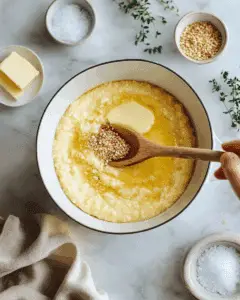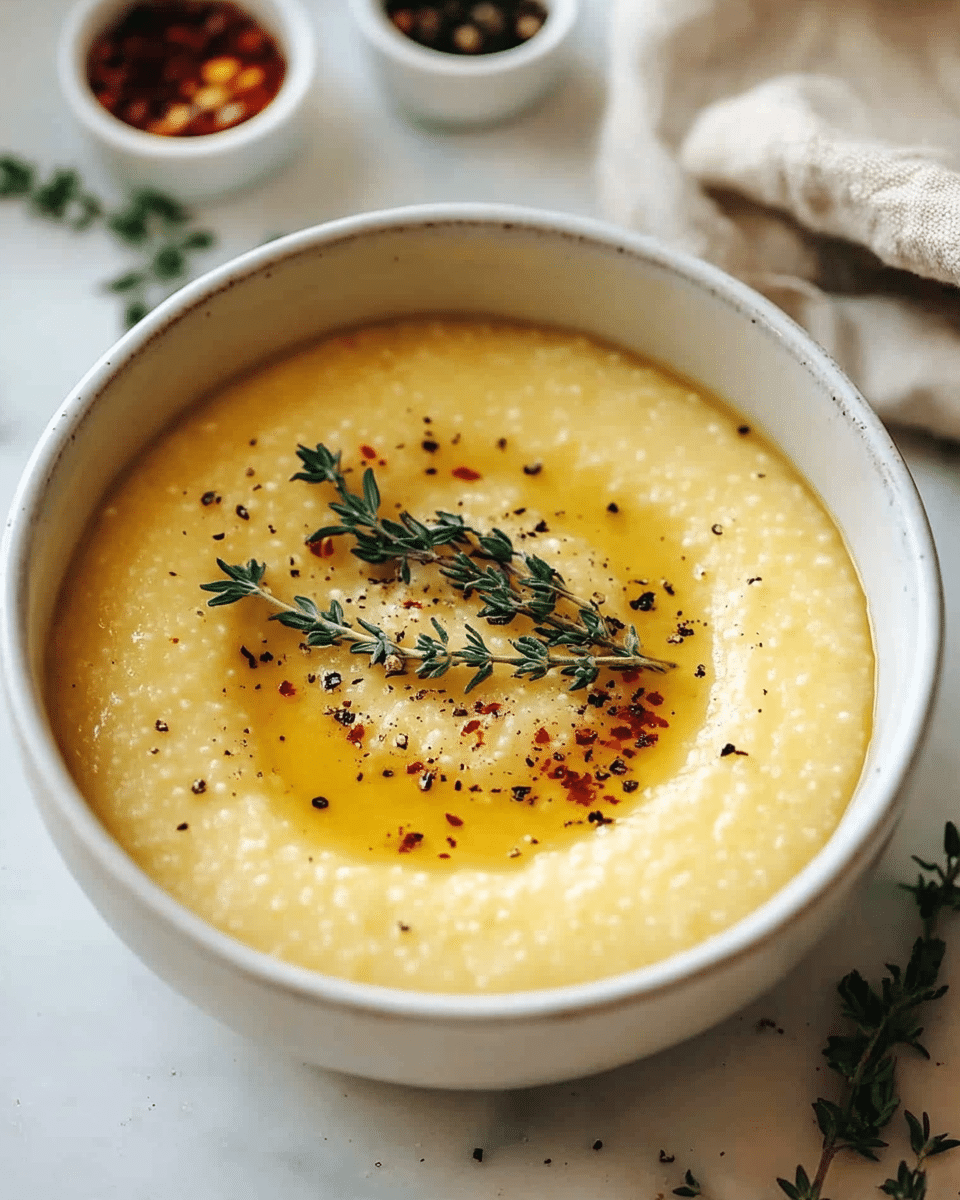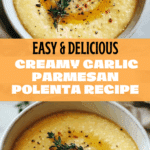This classic Italian comfort food combines smooth cornmeal with rich cheeses and aromatic garlic to create a dish that’s both elegant and homey. Creamy polenta makes the perfect base for savory toppings or stands beautifully on its own as a warming side dish.
Why You’ll Love This Recipe
This creamy polenta recipe transforms simple ingredients into something truly special. The velvety texture melts in your mouth while the parmesan adds a nutty depth that elevates the humble cornmeal to restaurant quality. It’s incredibly versatile – serve it alongside your favorite protein, top with sautéed vegetables, or enjoy it as a comforting meal on its own.
What makes this recipe a standout is its accessibility. Even kitchen novices can achieve perfect results, as the technique is straightforward and forgiving. The combination of garlic and parmesan creates a flavor profile that’s rich without being overwhelming, making it appealing to both adventurous eaters and those with simpler tastes.
Ingredients
(Tip: You’ll find the full list of ingredients and measurements in the recipe card below.)
Cornmeal is the foundation of polenta. Choose medium or coarse ground for traditional texture – finely ground corn will give you a smoother result but misses some of the delightful textural quality that makes polenta special.
Vegetable broth adds depth and savory notes that water alone can’t provide. It infuses the polenta with flavor from the beginning, creating layers of taste throughout.
Whole milk contributes richness and helps achieve that coveted creamy texture. The fat content is important for mouthfeel, though lower-fat alternatives can work in a pinch.
Butter enriches the polenta, adding silkiness and a subtle richness that complements the cornmeal beautifully. It helps carry flavors and creates a more luxurious final dish.
Garlic brings aromatic punch and warmth to the dish. Its pungency mellows as it cooks, leaving behind a beautiful savory foundation.
Parmesan cheese is crucial for authentic flavor. Its salty, nutty profile melds perfectly with the mild cornmeal base, creating complexity without overwhelming.
Salt enhances all the other flavors in the dish. Even with the saltiness of the parmesan, a touch more balances everything perfectly.
Black pepper adds subtle heat and complexity. Freshly ground is always preferable for the brightest flavor.
Dried thyme contributes an herbal note that complements the richness of the cheese and butter. Its subtle earthiness works beautifully with the corn flavor.
Red pepper flakes provide a gentle warmth rather than intense heat, awakening the palate without dominating the dish.

Directions
- Begin by mincing the garlic cloves. For a mellower flavor, sauté the minced garlic in a bit of butter over low heat until fragrant but not browned. Set aside.
- In a large, heavy-bottomed saucepan, combine the vegetable broth and milk. Bring to a gentle simmer over medium heat, stirring occasionally to prevent the milk from scorching.
- Once simmering, gradually pour in the cornmeal in a slow, steady stream while whisking continuously to prevent lumps from forming.
- Reduce heat to medium-low and cook the polenta, stirring frequently with a wooden spoon. This prevents sticking and ensures even cooking. Continue for 20-25 minutes, or until the mixture has thickened to a creamy, porridge-like consistency.
- When the polenta has reached your desired thickness, stir in the sautéed garlic, butter, grated parmesan, salt, pepper, dried thyme, and red pepper flakes. Mix thoroughly until the cheese has melted completely.
- Taste and adjust seasoning as needed. If the polenta seems too thick, gradually add small amounts of warm broth or milk until you reach your preferred consistency.
- Serve immediately, garnished with additional grated parmesan and a drizzle of olive oil if desired.
Servings and Timing
This recipe yields approximately 6 generous servings as a side dish or 4 servings as a main course. Preparation takes about 10 minutes, and cooking requires 25-30 minutes, bringing the total time to around 40 minutes. It’s best served immediately after cooking when the texture is at its creamiest.
Variations
Herb-Infused Polenta: Add fresh herbs like rosemary, sage, or basil during the final minutes of cooking for a fragrant twist.
Mushroom Polenta: Fold in sautéed wild mushrooms and a splash of truffle oil for an earthy, luxurious version.
Cheesy Polenta Trio: Replace some of the parmesan with fontina and gorgonzola for a complex, multi-cheese experience.
Baked Polenta Squares: Pour freshly made polenta into a greased baking dish, let cool completely, then cut into squares and bake until crispy on the outside.
Breakfast Polenta: Top with a poached egg, crumbled bacon, and fresh herbs for a satisfying breakfast variation.
Sundried Tomato & Olive Polenta: Mix in chopped sundried tomatoes and Kalamata olives for a Mediterranean-inspired dish.

Storage/Reheating
Polenta can be stored in an airtight container in the refrigerator for up to 4 days. Note that it will solidify as it cools – this is completely normal and expected.
To reheat creamy polenta, place it in a saucepan with a splash of broth, milk, or water (about 2-3 tablespoons per cup of polenta). Warm over medium-low heat, stirring frequently until it returns to a creamy consistency. You may need to add additional liquid gradually to achieve the original texture.
For a different approach, you can slice the cooled, firm polenta and pan-fry the slices in olive oil until golden and crispy on both sides. This creates a delicious contrast between the crisp exterior and tender interior.
If you want to freeze polenta, cool it completely, then transfer to freezer-safe containers. Freeze for up to 3 months. Thaw overnight in the refrigerator before reheating according to the instructions above.
FAQs
Is polenta the same as cornmeal?
Polenta refers to the dish, while cornmeal is the ingredient. Though they’re related, not all cornmeal is suitable for polenta. Look for medium or coarse ground cornmeal specifically labeled for polenta for authentic texture and flavor.
Why is my polenta lumpy?
Lumps typically form when cornmeal is added too quickly or when the liquid isn’t hot enough. To prevent lumps, bring your liquid to a simmer first, then add the cornmeal in a slow stream while whisking constantly.
Can I make polenta with water instead of broth and milk?
Yes, though it will be less flavorful and creamy. If using water, you may want to increase the amount of butter and cheese to compensate for the lost richness.
How do I know when polenta is done cooking?
Properly cooked polenta should be creamy and smooth, not gritty. The cornmeal should taste fully cooked without any raw flavor. It should flow slowly when spooned but not be soupy.
Can I make polenta in advance for a dinner party?
Yes, but it will thicken as it sits. Make it slightly thinner than desired, then keep warm in a double boiler, stirring occasionally and adding warm liquid as needed to maintain the right consistency.
Is polenta gluten-free?
Pure cornmeal polenta is naturally gluten-free, making it an excellent option for those with gluten sensitivities. Always check packaging to ensure no cross-contamination if this is a concern.
What can I serve with polenta?
Polenta pairs beautifully with braised meats, roasted vegetables, saucy dishes like ragu, sautéed greens, or grilled seafood. Its mild flavor makes it versatile enough to complement almost any main dish.
How can I use leftover polenta?
Leftover polenta solidifies when cool, making it perfect for slicing and grilling, baking, or frying. These crispy polenta cakes can be topped with sauce, vegetables, or used as a base for appetizers.
Can I make this recipe dairy-free?
Absolutely. Substitute the milk with a plant-based alternative like almond or oat milk, use olive oil instead of butter, and either omit the cheese or use a non-dairy alternative.
Why does my polenta sometimes taste bitter?
Bitterness can come from cornmeal that isn’t fresh or from certain varieties of corn. Using high-quality, fresh cornmeal and adding enough salt and fat (butter/cheese) will help balance and mask any slight bitterness.

Conclusion
Mastering creamy Italian polenta with parmesan opens up a world of culinary possibilities. This versatile dish bridges the gap between rustic comfort food and elegant cuisine, making it suitable for everything from casual family dinners to sophisticated entertaining.
What makes polenta truly special is its chameleon-like ability to transform based on what you serve it with. From a humble side dish to a stunning main course, its creamy texture and gentle corn flavor provide the perfect canvas for countless flavor combinations.
Beyond its delicious taste, there’s something deeply satisfying about stirring a pot of polenta as it slowly transforms from loose grains to velvety smoothness. It’s a connection to generations of Italian home cooks who have prepared this dish for centuries.
Whether you’re new to polenta or rediscovering an old favorite, this recipe delivers reliable results and endless adaptability. Your kitchen will be filled with wonderful aromas, and your table with satisfied smiles.
Print
Italian Polenta With Parmesan
Creamy garlic and Parmesan polenta is a comforting Italian dish, perfect as a side or base, offering rich and bold flavors with a smooth, creamy texture.
- Total Time: 35 minutes
- Yield: Serves 4
Ingredients
- 4 cups vegetable broth (or water for a lighter version)
- 1 cup yellow cornmeal (coarse or medium grind)
- 1 cup whole milk (or unsweetened almond milk for a dairy-free option)
- 3 tablespoons unsalted butter (or olive oil)
- 4 cloves garlic, minced
- 1 cup grated parmesan cheese
- ½ teaspoon salt (adjust to taste)
- ½ teaspoon black pepper
- ½ teaspoon dried thyme (optional but recommended)
- ¼ teaspoon red pepper flakes (for a hint of heat)
Instructions
- Prepare the Garlic: Mince the garlic and sauté it in butter or olive oil over low heat until fragrant to remove raw sharpness. Set aside.
- Heat the Liquid: Bring vegetable broth and milk to a simmer in a large pot over medium heat, stirring occasionally.
- Add the Cornmeal: Gradually whisk in the cornmeal in a slow, steady stream while whisking continuously to avoid lumps.
- Simmer and Stir: Lower heat to medium-low, and stir frequently as the polenta thickens. Cook for 20–25 minutes or until creamy and porridge-like in texture. Add warm broth or milk if too thick.
- Add the Flavor: Stir in sautéed garlic, butter, parmesan cheese, salt, pepper, and dried thyme. Mix well until cheese is fully incorporated.
- Taste and Adjust: Adjust seasoning or consistency as needed with more parmesan or warm liquid.
- Serve and Enjoy: Spoon onto plates, garnish with parsley, extra parmesan, and a drizzle of olive oil. Serve hot.
Notes
- Use high-quality, stone-ground cornmeal for better texture and flavor.
- Whisk constantly at the start to ensure a smooth consistency.
- Cook over low heat to prevent scorching.
- Polenta thickens as it cools, so serve immediately.
- To reheat firmed polenta, add a splash of warm liquid to restore creaminess.
- Prep Time: 10 minutes
- Cook Time: 25 minutes
- Category: Side Dish
- Method: Stovetop
- Cuisine: Italian
- Diet: Vegetarian
Nutrition
- Serving Size: 1 cup
- Calories: 210
- Sugar: 2g
- Sodium: 480mg
- Fat: 10g
- Saturated Fat: 6g
- Unsaturated Fat: 4g
- Trans Fat: 0g
- Carbohydrates: 23g
- Fiber: 2g
- Protein: 6g
- Cholesterol: 25mg


